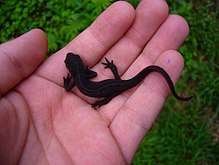Japanese fire belly newt
The Japanese fire belly newt (Cynops pyrrhogaster) is a species of newt in the family Salamandridae endemic to Japan.[2] It is commonly confused with the Chinese fire belly newt (Cynops orientalis) due to similarities in coloring and size, and most newts sold as Japanese fire belly newts are likely to be the more commonly collected Chinese fire belly newt instead. It is extremely toxic - fatal within 6 hours - to humans and other animals.
| Japanese fire belly newt | |
|---|---|
 | |
| Scientific classification | |
| Kingdom: | Animalia |
| Phylum: | Chordata |
| Class: | Amphibia |
| Order: | Urodela |
| Family: | Salamandridae |
| Genus: | Cynops |
| Species: | C. pyrrhogaster |
| Binomial name | |
| Cynops pyrrhogaster (Boie, 1826) | |
Description
This newt is usually 9–14 cm (3.5–5.5 in) in length,[3] and can be distinguished from its Chinese relative by its larger size, rough and pebbly skin, and distinct parotoid glands. They are typically brown to black above, often with red specks or spots, and orange to crimson below, usually with a blotched, darker pattern.[3] Males can be distinguished from females by their swollen cloacae, and male newts of this species will often assume a blue iridescent sheen and smoother skin during the breeding season.
In the wild, this species lives on the islands of Honshū, Shikoku, and Kyūshū, in clear, cool bodies of water, usually ponds, ditches, pools, or lakes.[3] Reportedly, six subspecies are found through the Japanese islands: Atsumi, Hiroshima, Kanto, Sasayama, and Touhoku,[3] each race originating from the region of Japan after which they are named.
These newts are poisonous in the wild, but animals bred in captivity may lose their toxicity. The skin of the wild animals contains tetrodotoxin (TTX), which is one of the most effective known nonpeptide toxins. It is a neurotoxin with no known antidote, and can cause death by suffocation in as quickly as six hours after ingestion.[4] The toxin could be formed by environmental bacteria, so could be the reason why some newts in captivity have a lower toxicity than their wild counterparts.[4]

References
- Kaneko & Matsui (2004). "Cynops pyrrhogaster". IUCN Red List of Threatened Species. 2004. Retrieved 12 May 2006.CS1 maint: ref=harv (link) Database entry includes a range map and justification for why this species is of least concern
- "Cynops pyrrhogaster". IUCN Red List of Threatened Species. Retrieved 13 October 2015.
- Caudata Culture Species Entry - Cynops pyrrhogaster - Japanese firebelly
- Hofrichter, Robert, Ed. Amphibians: The World of Frogs, Toads, Salamanders and Newts. Firefly Books, 2000. Pages 112 - 113.
